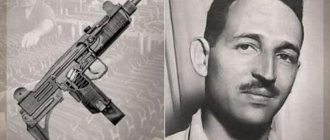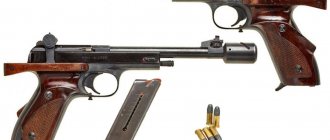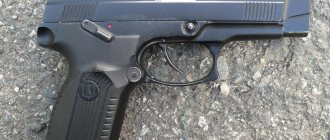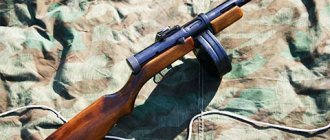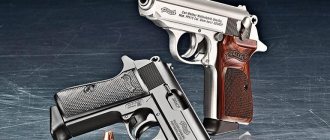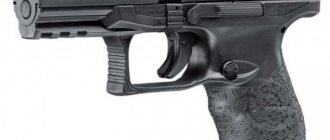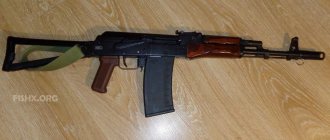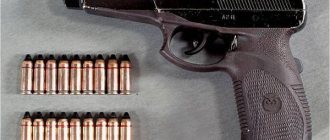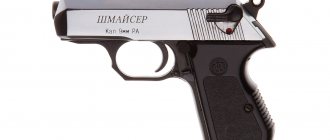History of creation
His friends called him Uzi, but Major Uziel Gal never wanted that name attached to the weapon he developed. But the Israelis simply ignored his request, and the Uzi submachine gun, one of the most iconic firearms in history, was born.
For Uzi, the creation story begins on May 14, 1948, when the state of Israel emerged, which was immediately attacked by the neighbors of the new country. Although the young Israelis fought off the attacks, it was clear that the new nation-state needed new firearms to replace the outdated weapons of World War II.
Uziel Gal was based on the Czech CZ25 submachine gun, developed in the late 1940s, which used an open bolt and a magazine inserted into the pistol grip. These main features formed the basis of the Uzi design.
Uzis were produced in several modifications, including two shortened versions (mini and micro versions). The most recent version of the Uzi Pro is still used by some special forces units.
Many people mistakenly use the name “Uzi machine”. In fact, this is not the case, because this weapon exclusively uses the 9 mm pistol cartridge. Therefore, the Uzi is a submachine gun, not an assault rifle.
Description
One of the main advantages of the Uzi is its excellent balance; the weapon can be fired with one hand. Moreover, it is possible to effectively conduct both single and automatic fire. Although, in single shooting mode the accuracy is higher. The handle of the submachine gun (also known as the magazine neck) is located under the center of gravity of the weapon, which makes the weapon so balanced.
In addition, the shot is fired as the bolt moves forward, which reduces the recoil of the weapon and makes the machine even more stable.
The Uzi operates according to the blowback design, the shot is fired almost in the extreme forward position of the bolt (the bolt running onto the barrel), which made it possible to make the submachine gun so compact. Most of the barrel of the machine gun is located directly in the body; placing the magazine in the handle made it possible to further reduce the size of the weapon.
The trigger mechanism has two firing modes: single and automatic. The fire mode selector is also a safety switch; another one is located on the back of the handle, making it impossible to shoot without covering it with your palm.
The stock is folding, metal. Different modifications have different designs.
This submachine gun uses the 9x19 mm Parabellum cartridge, but a more reinforced cartridge can also be used. The machine's magazine has different capacities: 25.32, 40 and 60 rounds. Reloading the machine gun is very convenient; the weapon can be reloaded in the dark or in poor visibility conditions without any problems.
Separately, it should be noted that the weapon is highly technological: most Uzi parts are produced by cold stamping, which makes it low cost and easy to manufacture.
You can also highlight the reliability of the Uzi. This weapon can be thrown into sand, into water, or simply thrown from a great height - it will still fire. Experts consider this submachine gun to be an “unkillable” weapon.
There are deep pockets on the sides of the bolt box that help remove dirt; all Uzi parts are made with large tolerances, which prevents the weapon from jamming.
On the first samples of this weapon, the fore-end and butt were made of wood, but after testing the Uzi in real combat, it was replaced with a steel folding one, and the fore-end began to be made of plastic.
Device
Gal based his weapon in part on designs for earlier Czech submachine guns, in which cartridges were fed into the chamber from a box magazine inserted into the pistol grip. The Uzi has a blowback action that travels along most of the barrel when fired. Gal combined these characteristics to create a weapon that was compact, had a lightweight loading mechanism, was reasonably stable and accurate even with automatic fire, and had good reliability.
The Uzi has a rectangular receiver with front and rear "half-round" sights on the ends of the receiver. The magazine is inserted into the pistol grip, with a round cocking handle on the receiver.
The barrel can have several different configurations. Its design ensures a very short overall length and makes the weapon insensitive to contamination. Operating on the principle of a bolt action and recoil spring, the Uzi can fire in full-automatic mode, but is also available in semi-automatic mode. It has a folding stock and can be equipped with a silencer.
The Uzi submachine gun is based on the open bolt principle. The bolt is located behind the pistol grip with the magazine. The shot occurs when the shutter is in the forward position. This arrangement offers several advantages. Firstly, the dimensions of the weapon are reduced, since most of the barrel is in the body, and secondly, the recoil is reduced, because at the moment of firing, the bolt moves forward.
The trigger has two fire modes: single and automatic. The fire switch is also a fuse. There is another automatic safety, which is located in the pistol grip; the safety on the famous Colt 1911 works on the same principle. If the hand does not clasp the grip and press the safety button, the shot will not fire.
The submachine gun has a folding metal stock.
Principle of operation
- When you press the trigger, the bolt first feeds the cartridge into the chamber
- Immediately after this there is a shot
- Under the influence of powder gases, the bolt returns to the rear position
- The cycle repeats
Micro UZI: a side view of the legendary submachine gun
I am sure that this small-sized submachine gun is very familiar to you. You've probably often seen it in the hands of heroes of various action films - sometimes you can see it in photos, in the hands of all sorts of "bad guys." Yes, this is Micro UZI UZI submachine guns .
It all started in 1976, as a response from the Israeli arms concern TAAS to new items on the arms market that offered small-sized submachine guns. These were, for example, the Czech “Scorpion” vz. 61 (which was created as a weapon for tank crews, artillery crews, etc., that is, for those who did not need a full-fledged assault rifle during their service), and the American MAS-10, and later the MAS-11. When these samples appeared, they quickly conquered their specific niche. The Israelis decided to keep up, but since they did not have any new developments in this area, the time-tested submachine gun designed by Uziel Gal was taken as a basis. This is roughly how the progenitor of the Micro UZI, the Mini UZI, was born.
The stock, for me personally, is short and awkward. As you can see in the photo, the former owner tried to “trick” a semblance of a cheek.
In 1984, for services that do not have the right to use automatic weapons, as well as for commercial sale, an even more compact version was released, which was called micro UZI. This version had only a single firing mode and did not have a stock or forearm. In essence, it turned out to be a cut-down (did you appreciate the humor?))) version of the Mini UZI submachine gun, more reminiscent in its functionality of a pistol with terrible ergonomics. Even the butt that appeared later did not save the situation.
However, the Israeli Air Force was very interested in this product, which, with some reservations, decided to purchase Micro UZI to equip emergency supplies for their helicopter pilots. It should be noted that hardened pragmatists have always served in the Israeli Air Force. Who knew how to count perfectly. And the formula was simple: the smaller dimensions of the weapon with the power of a submachine gun make it possible to put more ammunition, provisions, and medicines into the emergency stock. And already in 1985, responding to requests from customers from the Air Force, Micro UZI was developed with the ability to conduct automatic fire. This product had a slightly longer barrel, and also had a muzzle compensator.
Micro UZI submachine gun
Now let's talk about some technical aspects/solutions and design features of this submachine gun.
The brackets on the Micro Uzi have different shapes depending on the version.
The first thing you should know is that this submachine gun, like the entire UZI line, operates with an open bolt. When the bolt is in the extreme forward position, most of it is placed above the barrel, which made it possible to reduce the length of the weapon. To reduce the rate of fire, the Micro UZI bolt has a special tungsten weight insert, since the bolt itself in this version is light in weight and has a short stroke.
The magazine release button is large and conveniently located on the left side - in order not to tear off your “working” hand during shooting. But they didn’t think about what left-handers should do in this situation.
The safety switch is located on the left side of the receiver, above the pistol grip fire control. Safety in handling the weapon is also ensured by the automatic handle safety, the button of which is located in the rear part of the handle.
The receiver is made by stamping. The submachine gun is equipped with a steel butt that folds sideways to the right.
Small dimensions and simplicity of design are what made Micro UZI popular. Oh, and the price. Israelis know a lot about prices. It is curious that even in the USA Micro UZI replaced the MAC-10/MAS-11.
With all my love for compact weapons and respect for Israeli designers, this model of small arms disappointed me. The fact is that with its high rate of fire (1250 rounds per minute) and fairly low weight (only 2.5 kg with a loaded magazine), it is almost impossible to control it in automatic firing mode.
On the new Micro UZI models, in order to hold the weapon in this mode, a tactical handle was moved forward. However, in this model, the absence of a handguard forces the shooter to go to certain lengths to hold the weapon. It's much easier to hold a weapon in single player mode.
Another interesting fact is that the Micro UZI can only be worn on a single-point harness.
However, the weapon is extremely simple and unpretentious. A complete disassembly yields only 63 parts. If you assemble/disassemble this submachine gun a couple of times, you can say that you have studied the diagram and principles of its operation.
I’m very pleased with some modularity - all submachine guns of the UZI family come with the same type of magazines. Micro UZI is convenient for everyday carry - with some reservations it can be carried concealed (for example, under a jacket in an operational holster).
Returning to ergonomics, the handle is located at a right angle, which, coupled with the rather short butt, impairs the shooter’s grip.
To summarize, we can say that it was the small dimensions, simplicity of design and low cost of production that made the Micro UZI so popular, despite, frankly speaking, weak shooting characteristics. This weapon, which is still in production, has many supporters on both sides of the law.
Characteristics in comparison with analogues
The very first analogue that comes to mind for comparison with the Israeli Uzi assault rifle is the American Mac 10 pistol. They use the same ammunition (9x19), are similar in appearance, and are designed to perform the same tasks. These are two compact PDWs that are intended to be discreet self-defense weapons.
The MAC 10 and Uzi are submachine guns that have been in service with armies for a long time, and they both use pistol cartridges. The Uzi has a longer history, having been developed in the 1940s, while the MAC 10 or Model 10 was created in 1964.
Among experts, Uzi enjoys great prestige, primarily due to the fact that the design is more reliable and less susceptible to overheating.
Mac 10 weighs almost a kilogram less than Uzi (2.8 kg for MAC 10, versus 3.5 kg for UZI)
It also wins in length (548 mm for MAC 10 and 640 mm for UZI). The MAC 10 also benefits in barrel length, so the MAC 10 can confidently be called a more compact weapon.
Another difference is the rate of fire. The Uzi has a rate of fire of 600 rounds per minute, while the Model 10 has a rate of fire of 1090.
However, despite the above advantages of the Model 10, the Uzi is still considered the best PP. The first reason is the rate of fire. Due to the smaller dimensions, barrel length, but higher rate of fire, it is more difficult to control the weapon and shoot accurately. Model 10 is more susceptible to overheating and will lose to the UZI in reliability.
Conclusion: The MAC 10 is more compact and faster-firing than the Uzi. But due to the design features, the Uzi submachine gun has better accuracy, effective firing range and reliability.
Performance characteristics (TTX) of Uzi
The barrel length is only 260 mm (10 inches). The submachine gun weighs about 4 kg with a magazine. Magazines come with 25 or 32 rounds of 9 mm caliber. The Uzi also comes in miniature versions, measuring just 460mm in length.
| Ammunition used | 9x19mm Parabellum |
| Length | 640 mm |
| Barrel length | 260 mm |
| Weight | 3.5 kg |
| Magazine capacity | 25, 32 rounds |
| Rate of fire | 600 shots /min |
| Sighting range | 200-250 m |
Hungarian Micro-Uzi. Robert Veress pistol
In the article about the Warren Evans rifle, we were introduced to one of the first options for implementing an auger magazine.
The modern development of the idea can be traced to the Calico M960 and Bison submachine guns; earlier there was material about the Chinese submachine gun with an auger magazine, Chang Feng. In this article, we will try to get to know more closely another representative of this rare subspecies of weapons, which was supposed to live on the territory of Hungary, but, as often happens, was crossed out by ruthless evolution as unsuitable for survival. We will talk about the pistol of Robert Veres, which was “fed” from an under-barrel auger magazine with a capacity of 33 rounds. History of the development of the Veres pistol
In the process of studying any topic that goes deep into history, one cannot help but notice that many facts from the biographies of certain people coincide, and the developments themselves are often repeated. So, the designer Robert Veres had not previously worked with firearms, like the dentist Evans, however, he was still an engineer, so he had a more complete understanding of what he was doing and what he wanted to get as a result.
The main idea of the designer was to create a competitive pistol with a large-capacity magazine, which could be opposed to the Israeli Micro-Uzi. Just as in the case of Israeli weapons, it was decided to first make a version without automatic fire, and only then make a submachine gun based on the pistol. It is for this reason and layout that the variant of the weapon without automatic fire will be designated as a pistol, and the variant with the ability to fire in bursts as a submachine gun.
The main priority for the designer was the possibility of concealed carry and maintaining the functionality of the weapon, regardless of the quality and type of ammunition. Realizing that he did not have his own knowledge in the field of designing firearms to create a workable model, the designer worked only on the general concept and made a mock-up, which he presented at an exhibition in Nuremberg in 1989.
The efforts were not in vain; gunsmiths Hindlemeier and Wittner became interested in the project. The three designers managed to create the first functional weapon, which was named VHW, after the first letters of the names of the designers who worked on it. The new weapon had a magazine with a capacity of 36 9x19 rounds, but was still only a pistol, without the ability to fire automatically.
Veres failed to complete the work together with those with whom he started it. Disagreements between the designers and a number of everyday difficulties broke up this trio. I had to look for new partners, whom Robert Veres found in the German arms company Jagd-Hammer.
It was thanks to the designers from this company that it was possible not only to achieve the result that was originally planned by the engineer, but to organize the production of new weapons.
In the process of working on the new pistol, the magazine capacity had to be slightly reduced (to 33 rounds), while the magazine itself was redesigned several times in order to achieve an optimal balance between size, capacity and reliability. The bolt group also underwent changes, in search of a common basis for weapons with single and automatic fire. Special attention was paid to reliability in adverse conditions.
The first batch was small, only 60 units. The designer offered these pistols to collectors, who immediately bought them up. In addition to the civilian market, the designer has his sights set on a large order from the military, who were provided with several units with automatic fire capabilities for testing.
It must be said that the military was delighted with the new submachine gun. Both small dimensions and high reliability in case of heavy contamination of the weapon were noted. However, the results in terms of accuracy and accuracy of automatic fire left much to be desired, which is quite expected with such an arrangement and the absence of at least some kind of shoulder rest. However, these figures were better than those of the Israeli Micro-Uzi, since the submachine gun could be confidently held with both hands, using the magazine as a handguard.
Separately, it should be noted that the supply of ammunition in this PP was successfully implemented. During military tests, the submachine gun was equipped with cartridges with different types of bullets, as well as with different amounts of gunpowder, and there were no delays in automatic fire.
Despite good performance and a general good impression of the weapon, a large military order never came, since a niche for the new PP simply could not be found. Everything was limited to only a few small batches.
Veress pistol design
Despite the overall unusual appearance, the design of the pistol is quite simple, one might say, the most common. The automatic system with a blowback bolt is placed in the receiver, from which only two small stops for cocking the bolt are removed. The trigger mechanism is striker-fired. An auger magazine is also not new; we have seen the use of coiled springs inside a rotating auger more than once.
The weapon frame is made of aluminum alloy, which facilitates the overall design, and the receiver is made of steel. Between the adjustable rear sight and the front sight there is a button, which, when pressed, disassembles the weapon. Many compare the Veress pistol with the Micro-Uzi, finding common solutions in the design of the weapon. It is difficult to judge how correct this is. With the same success it can be compared with any other type of weapon with a similar bolt group design. But a comparison of characteristics is more than appropriate here, since the Veres pistol was originally designed as a competitor to Israeli weapons.
Characteristics of the Veress pistol
The total weight of the pistol is two kilograms without a magazine, which is a lot for a pistol, but quite acceptable for a submachine gun. The length of the weapon is 305 millimeters with a barrel length of only 127 millimeters. Such a short barrel and the layout of the pistol made it not the most accurate and accurate weapon; even the manufacturer claims an effective fire distance of up to 25 meters, and manufacturers usually like to overestimate this parameter. The height of the pistol is 160 millimeters. The thickness of the weapon due to the auger magazine is 61 millimeters.
To all this it’s a good idea to add the characteristics of the store itself. The weight of which without cartridges is 450 grams, and loaded with ammunition - 860 grams. The length of the magazine is 146 millimeters. Capacity - 33 rounds.
Conclusion
It is difficult to evaluate a pistol and a submachine gun. If we consider this weapon as a pistol, it becomes clear that any other model of this class will win both in terms of compactness and characteristics, in the end, simply in weight, so in the context of a pistol, the weapon in question is clearly not the best.
The difficulty of evaluation begins when considering the Veress pistol as a submachine gun. On the one hand, you can compare it with full-size weapon options, which are presented in huge quantities, and as a result of the comparison, you can conclude that the designer’s development has been a complete failure. On the other hand, we must not forget that this submachine gun was designed as a weapon for concealed carry, which means that many of its parameters were underestimated for the sake of smaller dimensions. And if we consider the Veres pistol as a special weapon, then we can give the designer a solid A, since he coped with the task.
Well, if we evaluate the Veres pistol as a competitor to the Israeli Micro-Uzi, then the weapon wins in all respects, except, of course, price.
Advantages and disadvantages of UZI
Pros:
Simplicity of design. The weapon is easy to disassemble and clean. This significantly increases its durability.
The parts are easy to manufacture. Thanks to the abundance of stamped parts, the weapon is inexpensive to produce
High reliability. Simplicity and large design tolerances keep delays and non-feeds to a minimum.
Relatively small dimensions. The weapon can be carried secretly under a raincoat or jacket. A special shoulder holster was created for this purpose.
Good weight distribution of weapons.
Minuses
Its main drawback is that it only fires pistol ammunition. This leads to reduced, in comparison with assault rifles, accuracy, firing range, bullet speed, striking and penetrating ability. The Uzi is a melee weapon.
Combat use
At first, the weapon was popular only in the Israeli Armed Forces. It was put into service in 1956 and was used as a PDW (Personal Defense Weapon or weapon for self-defense), primarily by artillerymen and tank crews, for whom an assault rifle was too large and heavy. The weapon was used by the Israeli army during the Suez Crisis (1956), the Six Day War (1967) and the Yom Kippur War (1973).
Perhaps Uzi's most famous appearance outside of Israel occurred in March 1981, when a mentally unstable man named John Hinckley Jr. attempted to assassinate President Ronald Reagan with a .22-caliber revolver. The President was seriously wounded by the ricochet. A famous photograph from that day shows Secret Service Special Agent Robert Vanko, Uzi in hand, surveying the crowd as the President and other wounded were evacuated. The Uzi remained the Secret Service's PDW of choice well into the 1990s.
At the moment, the Uzi is not in service with the army in Israel, as it is outdated. The Uzi replaced the Tavor and M4A1 carbines.
The newest modification of the Israeli software "Uzi" - "Uzi Pro"
IDF - The Israeli Armed Forces acquired a shipment of new weapons - the Uzi Pro SMG. After conducting comprehensive combat and technical tests, the IDF could not decide whether to adopt this submachine gun or not.
Uzi submachine gun - design work began in 1948. Today, the Uzi SMG is the most common weapon of its class. To date, more than 1,500,000 copies of this submachine gun and its modifications have been mass-produced. The standard Uzi SMG today is inferior to similar modern developments from various weapons manufacturers. The basis of the standard Uzi software is steel parts, and modern submachine guns have long been made from light metal alloys or plastics. All this gives the new PP samples reduced weight characteristics, comfortable wearing and quick use for their intended purpose.
In order not to lose its leading position in the arms market in this segment, in 2010 the Israeli company began pilot production of a new modification of the Uzi software - the Uzi Pro software. For the first time, the company introduced the newest modification to everyone at the end of 2003 at the eighth Paris arms exhibition MILIPOL.
Design features of the Uzi Pro software modification.
The modification is based on an earlier modification of the submachine gun – the Uzi Micro PP.
The layout remained virtually unchanged. A magazine with ammunition is inserted into the handle to control fire. The automation, which operates on the recoil energy of the free-wheeling shutter, also remained unchanged. The compactness of the submachine gun is ensured by the movement of the bolt over most of the barrel when firing a shot.
Firing occurs from a closed bolt, both in bursts and in single shots. The rate of fire remained low, about 700 rounds per minute. The handle for cocking the bolt was moved to the left side of the barrel box. A distinctive feature of the submachine gun is that one of the components of the barrel box is made of one product with a handle. This part is made of high-strength plastic alloys. The places on the submachine gun are made of high-strength plastic alloys, which are subject to increased loads, and are reinforced with special steel inserts. At the rear, the submachine gun has an attached shoulder rest made of light metal alloys. In the portable version, the stop folds to the right, parallel to the barrel box, and, if necessary, can serve as an additional front handle.
The submachine gun uses 9x19mm Parabellum caliber ammunition for firing. The magazine has a straight box design. The magazines are compatible with other modifications of the Uzi software. The design of the submachine gun allows it to be used by both right-handers and left-handers. To perform aiming, the submachine gun is equipped with a front sight and a reversible diopter for 150 meters and 50 meters. A modern guide is equipped on top of the barrel box, “Picatinny rail”, on which additional equipment can be mounted - for example, a night sight or optical sight, a flashlight or a laser target designator.
The manufacturer does not provide more precise technical data, explaining that work on the modification has not yet been completed. The head, Mr. U. Amit, made a statement that in future wars, that is, in urban wars, this weapon of the company, which is a modern, powerful and compact submachine gun, will definitely become the main element of the weapons of various paramilitary units.
Known characteristics:
— weight 2.32 kilograms; — length with butt 53 centimeters; — own length 28.2 centimeters.
Modifications
Uzi has several modifications.
- Mini Uzi
The Mini Uzi has a folding stock. Due to the weapon's downsizing, the receiver is smaller, the bolt is smaller, and the barrel is shortened to approximately 7.75 inches (196 mm). The rate of fire is 950 rounds per minute. Production began in 1980.
- Micro Uzi
The Micro Uzi is scaled down even more than the Mini Uzi; It has a 4.7-inch barrel and fires at 1,200 rounds per minute. A stock can also be used on this weapon. Production began in 1983.
- Uzi Pro
In this variant of the Micro Uzi, the cocking handle has been moved to the left side of the receiver. The grip and fore-end are made of polymer, and the grip design has been modified to allow two-handed grip, which would improve shooting technique and allow for more precise control of the weapon. The Uzi Pro has two rails on the barrel and one on top for mounting scopes and other tactical equipment. Production began in 2010.
- Norinco Model 320
An unlicensed copy of an Uzi made in the mid-1990s in China by Norinco, with a wooden stock.
Chilled Uzi
Quite a rare and very expensive example. Remade in Russia from the original Israeli Uzi. Uses a 10x31 blank cartridge. All functions and controls are retained. The only change is the deactivation of the weapon's warheads to eliminate the possibility of firing live ammunition.
Traumatic Ultrasound
At the moment, there is no sample that completely copies the combat prototype. However, in 2009, a traumatic pistol was created in Turkey, created in the image and likeness of the Uzi, which is called the Zoraki 925. It is extremely vaguely reminiscent of the Uzi, because it has the same magazine mounting system in the handle, and it also has similar features in appearance.
The submachine gun is manufactured by Zoraki in Turkey, uses a 9 mm PAK cartridge, has an automatic firing mode and a magazine capacity of 16 to 25 pieces.
This submachine gun was copied and remade by a Russian company with some changes (10-round magazine and no automatic fire mode), because otherwise the pistol would not have passed the requirements of Russian legislation.
Pneumatic versions
Produced by several companies. The largest of them: Umarex, Gletcher. In general, they differ little from each other. They use CO2 canisters and shoot 4.5 mm balls. They have an external replica of the original, but differ significantly in weight. All controls (including the automatic safety in the handle) are retained. Sold without a license.
Recommendations for using Uzi air pistols
Perhaps the main recommendation when using the Uzi submachine gun is constant care of the barrel and main mechanisms. This includes cleaning and lubricating the inside of the barrel.
- Constant care of the insides of the pneumatic is required. Including cleaning and lubricating the inner barrel.
- Don't skimp on balloons and gas cylinders. Low-quality components will lead to increased wear of the “weapon” and rapid failure.
Mass-dimensional model (MMG)
This is an original Israeli machine gun, to which design changes have been made to deactivate the weapon. MMG has only collection value. Deactivation: the barrel is drilled, the chamber is welded, a welded steel pin is inserted into the chamber through the receiver (which eliminates the need to replace the barrel), the bolt mirror is cut off.
Submachine gun UZI / Micro UZI / Mini UZI (Israel)
Uzi submachine gun with a metal folding stock in firing position.
Uzi submachine gun with metal folding stock in folded position.
Uzi submachine gun with a detachable wooden stock.
Mini-Uzi submachine gun with folded stock.
Mini-Uzi submachine gun with folded stock.
Micro-Uzi submachine gun with folded stock.
Micro-Uzi submachine gun with folded stock.
Characteristics
| Characteristic | Meaning |
| Automation type | manual reload |
| USM type | sa |
| Length, mm | 650, 600, 460 |
| Length with stock folded, mm | 470, 360, 250 |
| Barrel length, mm | 400, 197, 117 |
| Weight without cartridges, kg | 3.7, 2.7, 1.5 |
| Magazine capacity, cartridges | 20, 25, 32 |
| Rate of fire, rounds/min | 600, 950, 1250 |
The Uzi submachine gun was created in Israel by army lieutenant Uziel Gal in 1949. It is usually believed that Gal borrowed the basic idea of the layout of his submachine gun from the Czech PP models 23 and 25 designed by Holek, however, it is also likely that Gal “spied” the layout from the experimental English MCEM-2 submachine guns developed back in 1944. It is also possible that he himself “invented” the layout of a submachine gun with a magazine in the fire control handle and a bolt running onto the barrel - after all, a similar layout has been used in pistols since the end of the 19th century. Be that as it may, Gal created a rather original and technologically advanced design. The Uzi submachine gun was produced by the Israeli arms company IMI (currently IWI Ltd), currently the production of all variants of the Uzi submachine gun except the Uzi Pro variant has been discontinued. The Uzi submachine gun was or is in service in more than 90 countries, including Israel, Germany, and Belgium. The Mini- and Micro-Uzi variants are very popular among special operations forces and security services around the world. Under license, Uzi was produced in Belgium by FN Herstal and in the USA by Vektor arms (from Israeli components); without a license, copies were produced in China and Croatia.
The Uzi submachine gun (like its later, smaller variants Mini-Uzi and Micro-Uzi) is built using a blowback design. The fire is fired from an open bolt, while the primer is punctured before the bolt reaches its extreme forward position, which makes it possible to reduce the weight of the bolt. For the Mini-Uzi and Micro-Uzi variants, variants are also available that fire from a closed bolt and have a separate firing pin with its own mainspring. The Micro-Uzi version, to reduce the rate of fire with a low bolt weight and short recoil, has a special weighting insert in the bolt made of tungsten. In the extreme forward position, the bolt “runs” onto the breech of the barrel, which makes it possible to slightly reduce the length of the weapon. The fire mode switch fuse is located on the left side of the receiver and has three positions - safe, single, automatic fire. In addition, on the back of the handle there is an automatic safety button, which allows you to fire only when you cover the handle with your hand. The receiver is stamped from steel, with a folding stock attached to the rear. In Uzi it is made to fold down, in Mini-Uzi and Micro-Uzi it folds sideways. Early versions of the full-size Uzi submachine guns could also be equipped with removable wooden stocks. The loading handle is located on top of the receiver and is motionless when firing. All variants of Uzi submachine guns can be equipped with shot silencers; “full-size” versions can also be used to launch rifle grenades from the barrel using special blank cartridges. In addition, “full-size” versions intended for arming infantry could be equipped with a detachable bayonet.
Accessories for Ultrasound
The early version of the Uzi has two accessories. This is a muffler designed to reduce the sound of a shot and a wooden stock (standardly installed on the German version of the Uzi, known as MP2).
The later modification of the Uzi-Pro has rails for attaching attachments, which dramatically expands the range of accessories. These can be sights, flashlights, tactical grips, laser target units.
